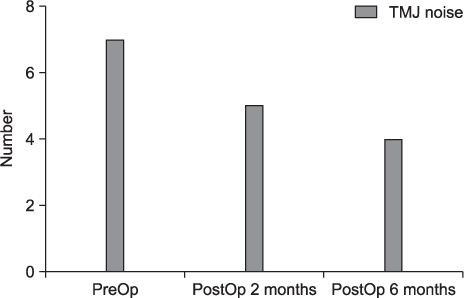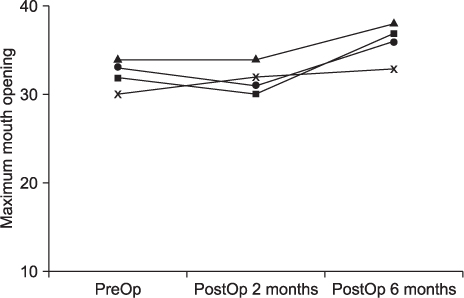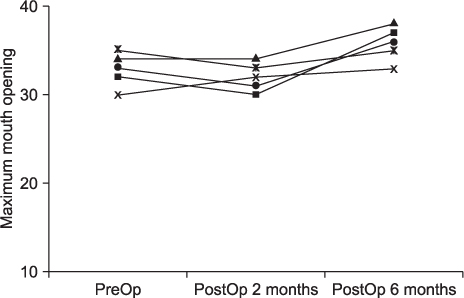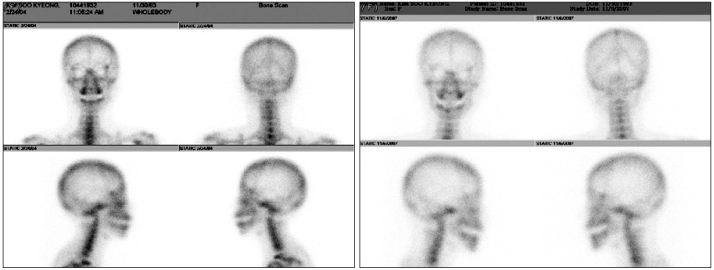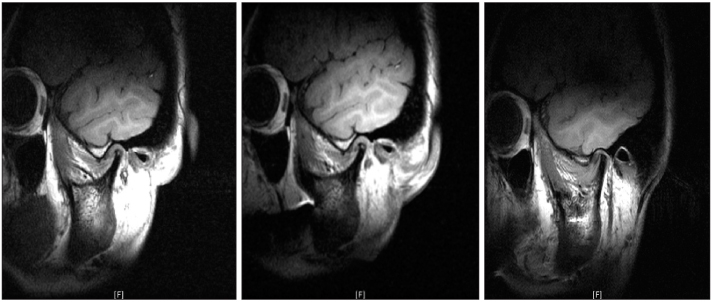J Korean Assoc Oral Maxillofac Surg.
2012 Jun;38(3):139-144. 10.5125/jkaoms.2012.38.3.139.
Clinical evaluation of temporomandibular joint disorder after orthognathic surgery in skeletal class II malocclusion patients
- Affiliations
-
- 1Department of Oral and Maxillofacial Surgery, Mokdong Hospital, School of Medicine, Ewha Womans University, Seoul, Korea. sjsj7777@ewha.ac.kr
- KMID: 2043842
- DOI: http://doi.org/10.5125/jkaoms.2012.38.3.139
Abstract
OBJECTIVES
This study was performed in order to evaluate the occurrence of temporomandibular joint disorder after surgical correction of skeletal class II malocclusion.
MATERIALS AND METHODS
This study included 21 patients who underwent orthognathic surgery for the correction of dentofacial deformities by a single surgeon at Mokdong Hospital, Ewha Womans University from 2000 to 2010. They underwent bilateral sagittal split ramus osteotomy for the treatment of undesirable mandibular advancement. The temporomandibular disorder (TMD) symptoms prior to surgery were recorded and the radiographic evaluation (panorama, bone scan, and magnetic resonance imaging [MRI]) of the post-surgery temporomandibular joint (TMJ) were assessed in order to evaluate condylar resorption, remodeling and disc displacement. The minimum follow-up period, including orthodontic treatment, was 12 months. Orthognathic procedures included 1-jaw surgery (n=8 patients) and 2-jaw surgery (n=13 patients). The monocortical plate was used for bilateral sagittal split ramus osteotomy fixation.
RESULTS
Among class II malocclusion patients with TMD symptom, clicking improved in 29.1%, and maximum mouth opening increased from 34.5+/-2.1 mm to 37.2+/-3.5 mm. The differences were not statistically significant, however. Radiographic changes in bone scan improved slightly based on the report by radiologist but not in TMJ dynamic MRI.
CONCLUSION
No particular improvements were found in patients with joint sound only. Patients with limitation of mouth opening showed an increase in the degree of opening, but the difference was not statistically significant (P>0.05).
Keyword
MeSH Terms
Figure
Cited by 1 articles
-
Complications associated with orthognathic surgery
Young-Kyun Kim
J Korean Assoc Oral Maxillofac Surg. 2017;43(1):3-15. doi: 10.5125/jkaoms.2017.43.1.3.
Reference
-
1. Wisth PJ. Mandibular function and dysfunction in patients with mandibular prognathism. Am J Orthod. 1984; 85:193–198.
Article2. Magnusson T, Ahlborg G, Svartz K. Function of the masticatory system in 20 patients with mandibular hypo- or hyperplasia after correction by a sagittal split osteotomy. Int J Oral Maxillofac Surg. 1990; 19:289–293.
Article3. O'Ryan F, Epker BN. Surgical orthodontics and the temporomandibular joint. I. Superior repositioning of the maxilla. Am J Orthod. 1983; 83:408–417.4. Sanders B, Kaminishi R, Buoncristiani R, Davis C. Arthroscopic surgery for treatment of temporomandibular joint hypomobility after mandibular sagittal osteotomy. Oral Surg Oral Med Oral Pathol. 1990; 69:539–541.
Article5. Lee JY, Kim SG, Seung JH, Ahn JM. Alterations of temporomandibular joint symptom after orthognathic surgery. J Korean Assoc Maxillofac Plast Reconstr Surg. 2003; 25:448–451.6. White CS, Dolwick MF. Prevalence and variance of temporomandibular dysfunction in orthognathic surgery patients. Int J Adult Orthodon Orthognath Surg. 1992; 7:7–14.7. Kerstens HC, Tuinzing DB, van der Kwast WA. Temporomandibular joint symptoms in orthognathic surgery. J Craniomaxillofac Surg. 1989; 17:215–218.
Article8. Wolford LM, Reiche-Fischel O, Mehra P. Changes in temporomandibular joint dysfunction after orthognathic surgery. J Oral Maxillofac Surg. 2003; 61:655–660.
Article9. Proffit WR, Phillips C, Dann C 4th, Turvey TA. Stability after surgical-orthodontic correction of skeletal Class III malocclusion I. Mandibular setback. Int J Adult Orthodon Orthognath Surg. 1991; 6:7–18.10. Panula K, Somppi M, Finne K, Oikarinen K. Effects of orthognathic surgery on temporomandibular joint dysfunction. A controlled prospective 4-year follow-up study. Int J Oral Maxillofac Surg. 2000; 29:183–187.
Article11. Aoyama S, Kino K, Kobayashi J, Yoshimasu H, Amagasa T. Clinical evaluation of the temporomandibular joint following orthognathic surgery--multiple logistic regression analysis. J Med Dent Sci. 2005; 52:109–114.12. Farella M, Michelotti A, Bocchino T, Cimino R, Laino A, Steenks MH. Effects of orthognathic surgery for class III malocclusion on signs and symptoms of temporomandibular disorders and on pressure pain thresholds of the jaw muscles. Int J Oral Maxillofac Surg. 2007; 36:583–587.
Article13. Dervis E, Tuncer E. Long-term evaluations of temporomandibular disorders in patients undergoing orthognathic surgery compared with a control group. Oral Surg Oral Med Oral Pathol Oral Radiol Endod. 2002; 94:554–560.
Article14. Pahkala RH, Kellokoski JK. Surgical-orthodontic treatment and patients' functional and psychosocial well-being. Am J Orthod Dentofacial Orthop. 2007; 132:158–164.
Article15. Lindenmeyer A, Sutcliffe P, Eghtessad M, Goulden R, Speculand B, Harris M. Oral and maxillofacial surgery and chronic painful temporomandibular disorders--a systematic review. J Oral Maxillofac Surg. 2010; 68:2755–2764.
Article
- Full Text Links
- Actions
-
Cited
- CITED
-
- Close
- Share
- Similar articles
-
- A study of the characteristics of craniofacial skeleton on orthognathic surgical cases with skeletal Class III malocclusion
- A study on the difference of the skeletal maturity in normal occlusion and malocclusion
- A study of the etiology of unilateral Class II, division 1 malocclusion
- 2 Phase Treatment Without Preoperative Orthodontics In Skeletal Class III Malocclusion
- A study of the calcification of the second and the third molars in skeletal Class II and III malocclusions

